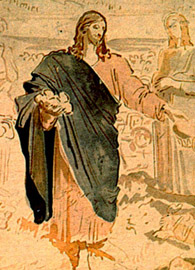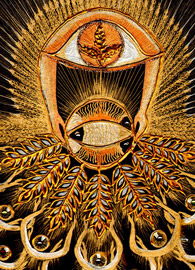John Week 4
Celebrating Jesus: Life out of Death Over and Over and Over Again: John 5:1–7:52
Seattle Pacific University Assistant Professor of New Testament
Read this week’s Scripture: John 5:1–7:52
13:43
Key Prologue Terms: life, testimony, sight/signs, God, Father/Son, dwell, beginning
Holiday Traditions

 Enlarge
Enlarge
Most of us love celebrations. Often our favorite celebrations are those that mark special days like birthdays or holidays. I wonder how we would respond to someone coming to us and telling us that we were doing our celebrations wrong, or that we completely misunderstood what these celebrations meant. I doubt we would welcome their comments.
Something similar is happening in chapters 5–7 of John’s gospel. Jesus is redefining the traditions of three Jewish celebrations: Sabbath, Passover, and Booths. Of course this is far more distressing to many of the religious leaders of Jesus’ day than someone telling me that I shouldn’t make Christmas cookies. The religious leaders believed that they were following God’s law by celebrating these holidays in the way that they did. Instead, Jesus illuminates the underlying meaning of these celebrations. Just as Jesus’ resurrection transforms death into abundant life, Jesus interprets each of these celebrations using the motif of life out of death.
The overarching theme that connects each of the celebrations of Sabbath, Passover and Booths is the question of Jesus’ identity. His relationship with God, how he brings the life he claims to offer, and his control over events are all central themes of these chapters. These themes are interwoven with an emphasis on authoritative interpretation of Scripture. Furthermore, these chapters also allow us to see the growing positive and negative responses to Jesus. These widely varying responses continue to be instructive for disciples today.
Sabbath: Working on a Day of Rest
John’s gospel first uses a story of healing to highlight how the Sabbath commemorates God bringing life out of death. John 5 begins with Jesus going up to Jerusalem for a festival. Unlike elsewhere in the gospel (e.g., 6:4; 7:2), we do not know which festival this might have been. In some ways we are encouraged to read this passage about Jesus healing a lame man on the Sabbath as though the Sabbath itself were the festival (a time set apart from “normal” time for God’s purposes). Here the narrative stresses Jesus’ control. Jesus decides to heal the man even though the man has not requested healing (5:8). Following the healing, Jesus pointedly commands the man to take up his mat. [Author’s Note 1]
The Jerusalem authorities see the formerly paralyzed man carrying his mat (5:10). Their interpretation of the law prohibited carrying items on the Sabbath because that was defined as work instead of Sabbath rest (cf. Nehemiah 13:19; Jeremiah 17:19–27). Therefore Jesus’ command is in direct violation of Sabbath law.
Jesus makes the radical claim that he is working just like God is on the Sabbath. This seems particularly unusual in light of texts like Genesis 2:2–3 that describe the establishment of the Sabbath on the seventh day, when God “rested from all the work that he had done in creation” (Genesis 2:3). On the contrary, Jesus illustrates a principle found in later rabbinic texts: God’s work of caring for creation, of bringing about life (through new babies, for example), does not cease on the Sabbath. [Author’s Note 2] Jesus interprets his actions toward the paralyzed man in the same light: he was giving the man a chance at new life that the pool at Beth-zatha never gave him (5:7).
Sabbath: Life Eternal Now
Jesus emphasizes that God is a God who brings life out of death, and this is what his own actions do too (5:21). Jesus’ healing of the paralyzed man also explains what Jesus means by “eternal life” (see 5:24). The paralyzed man moved from a situation of death, which he had endured for thirty-eight years (5:5), to a new life. By hearing Jesus’ words and believing in God who sent Jesus, the healed man has already “passed from death to life” (5:24). Eternal life is life with Jesus now, as well as in the future coming hour (5:28–29). [Author’s Note 3]
Passover: Food, Moses, and Jesus
Jesus redefines aspects of the Passover celebration using the motif of life out of death (John 6) as well. In this part of the gospel the Passover celebration connects to two different theological points. First Jesus offers an elaborate feast of bread and fish in the wilderness, similar to God feeding the Israelites in the wilderness after they left Egypt (see Exodus 16). Next Jesus interprets this event by identifying his body as “the bread of life” that turns death into life.
At the beginning of John 6, Jesus has returned to Galilee. Here John’s gospel describes two miracles, the feeding of the 5,000 (6:5–13) and Jesus’ walk on the water (6:16–21). The primary background of these events is the Feast of Passover (6:4). These passages focus on the way God fed Israel in the wilderness (Exodus 16) and God’s deliverance of Israel by providing a way through the sea, events surrounding the first Passover (Exodus 14–15).
The feeding of the 5,000 is the only miracle besides Jesus’ resurrection attested to in all four canonical gospels. John in particular highlights Jesus’ role as the host of the meal. Jesus makes the people sit down, gives thanks for the loaves and fish, and distributes this meal to all (6:10–11). By consolidating all of the action into Jesus’ hands, the evangelist emphasizes how much control Jesus retains. Even when he asks for the disciples’ participation it is only “to test” them, as Jesus already knows what he’s going to do (6:6). Because Jesus has acted like Moses providing them with food in the “wilderness,” the people see him as a prophet, perhaps even the prophet that Moses promised would come (6:14; cf. Deuteronomy 18:15). As a result of this miraculous feeding, the people want to make Jesus their king.
Jesus escapes to the mountains and the disciples leave. In order to join his disciples, Jesus walks three to four miles across stormy waters. This demonstrates that Jesus has the same control over the seas as Yahweh does in the Old Testament (cf. Psalms 77:19; 107:23–32). It also points back to the way that God delivers Israel from Egypt through the waters of the sea. Indeed, in alluding to Exodus again, Jesus declares, not “It is I,” as the NRSV translates John 6:20, but rather, “I AM,” God’s name revealed to Moses at the burning bush in Exodus 3:14–15. This is not simply a prophet or a king: this is Yahweh, the God of Israel. It is no wonder that Jesus has to tell his disciples not to be afraid (6:20).
Passover: Thanksgiving for Bread of Life

 Enlarge
Enlarge
The gospel summarizes the miraculous feeding of the 5,000 with the phrase “they had eaten the bread after the Lord had given thanks” (6:23). This highlights Jesus’ act of thanksgiving. The phrase “had given thanks” is a translation of the verb εὐχαριστέω (eucharisteō), from which we derive the word Eucharist. The Gospel of John does not preserve the traditions that Matthew, Mark, and Luke (and 1 Corinthians) do. In these texts Jesus celebrates a last Passover meal with his disciples, where he declares that the bread he breaks is his body and the wine they drink is his blood. However, it seems that John knows of this tradition and has integrated it here in the gospel. Essentially John is claiming that the celebration of the Eucharist is not just about Jesus’ death and therefore is not located at the end of his life. Instead it is a celebration, a thanksgiving, of his life and the abundant life that he brings now (seen here in the numbers of leftovers, 6:13).
Therefore, as Jesus provides the interpretation of the miraculous feeding and walking on water, he proclaims that he is “the bread of life” (6:35), just as he earlier claimed to provide living water (cf. 4:14). The crowd does not see the feeding of the 5,000 rightly, meaning that they do not see how it reveals the presence of God bringing life (food) out of death (starvation), even though John has described it as a sign to the gospel’s audience (6:14, 26). While the crowd wants to see miraculous deeds and call them works of God, Jesus claims that they need to embrace the work of God, which is faith in the one God has sent (6:29). He asks the crowd to respond in faith, which means that they should see and believe as well as hear and learn (6:45) what God is teaching them. Just as seeing Jesus’ body and blood in the bread and wine of the Lord’s Supper requires faith, so seeing God’s presence in Jesus’ ministry requires revelation. To see rightly, according to John, is to believe (6:36).
Jesus’ symbolic description of the Eucharist concludes by telling his disciples to eat his flesh and drink his blood — to be cannibals and vampires if they interpret the verses literally. Such graphic language, particularly offensive to Jewish ears (6:60–61; cf. Genesis 9:4; Leviticus 3:17), is used to highlight the importance of Jesus’ flesh. While later verses make it sound like the flesh is nothing, and everything is simply spiritual (6:63), this disturbing image of chewing on Jesus’ flesh is meant to remind John’s readers that the radical claim of this gospel is not that God is Spirit (4:24) but that God has become flesh (1:14).
Booths: Jesus’ Identity and Control
In John 7, Jesus comes to Jerusalem for the Festival of Booths (also called the Feast of Tabernacles). The Festival of Booths was one of the three Jewish pilgrimage festivals for which, according to the law, all Jewish males would travel to Jerusalem. [Author’s Note 4] The other two pilgrimage festivals were Passover and Pentecost. The purpose of the Festival of Booths is to offer God thanks for the harvest and to pray for rain for the coming year. The Torah and prophets offer instructions about celebrating the festival, and they include directions for the Israelites to construct “booths,” or tents, out of various woods to remind themselves of Israel’s mobile lifestyle in the wilderness after God delivered them from Egypt (see Leviticus 23:34–43; Deuteronomy 16:13–17; Nehemiah 8:14–18).
In this passage (7:1–9) Jesus’ brothers are mimicking the crowd’s action (6:30), asking Jesus to go to Judea so that his disciples can “see the works” he is doing (7:3). A group of disciples larger than the Twelve (6:60–66) is probably in mind here. [Author’s Note 5] This request is ironic, as the following narrative demonstrates; neither the crowds nor the disciples in Judea or Galilee have been able to “see” the signs and interpret them accurately.
Jesus echoes the words of the gospel’s prologue in his reply, claiming that the world hates him (1:10–11; cf. 15:18–25). Much as at the wedding at Cana, where Mary’s request did not convince Jesus to turn water into wine, here Jesus’ brothers will not convince him to go up to the festival. His time (καιρός, kairos) has not yet come; in other words, this is not the festival where he will be arrested, even if the authorities want to kill him (cf. 5:18). Jesus does go up to the festival, but unlike his previous activities in John, he goes up in secret (7:10). He has gone up to Jerusalem under his own control and in his own time.
Booths: Wilderness and Water
There are allusions to the wilderness wanderings throughout this section as people complain or mumble (6:41, 43, 61; 7:12, 32) just as the Israelites did (e.g., Exodus 17:3; Numbers 14:27). Later rabbinic materials describe the priest celebrating the last day of the Festival of Booths by pouring “living” or “flowing” water, emphasizing the prayer for rain for the coming year. This provides the setting for Jesus’ comments. Jesus links all of the teachings that he has given since chapter 4. He is the living water that he offered the woman (4:14). He is the bread of life that he offers the world (6:51). Jesus is connected to those who believe in him by causing water to “spring up” inside of them through the work of the Spirit. [Author’s Note 6]
Traditions Revisited
Jesus’ words in these chapters offer a pointed reminder to us. By revealing the underlying meaning of each celebration he breathes new life into the traditions and celebrations of the first century. Which of our dead traditions does he desire to resurrect so that we can see his true identity clearly? These are hard teachings, as the disciples noted (6:60). However, they are also “the words of eternal life” (6:68). [Author’s Note 7]
Questions for Further Reflection
- What traditions in your life, or in your church’s life, do you think Jesus would want to resurrect? In what ways? How would such resurrection help you and others see Jesus’ identity more clearly?
- In these chapters Jesus proclaims that he is the I AM, the God of Israel, as well as the Bread of Life and Living Water. What do these metaphors or names mean about Jesus’ identity?
- Look back through these chapters at each feast — Sabbath, Passover, and Booths. How do different people, or groups of people, respond to Jesus? What do you think the gospel is trying to teach its readers about our potential responses to Jesus?
<<Previous Lectio Back to John Next Lectio>>

This work is licensed under a Creative Commons License.




